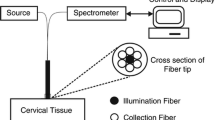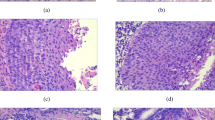Abstract
The screening results were reported based on the Fourier transform infrared spectroscopy (FTIR) analysis of the samples of exfoliated cervical cells from 354 women. Their spectra can be sorted into two types based on the emerging or not of the absorption bands near 970 cm−1 and 1 170 cm−1: T1 (83.1%) type without emerging, and T2 (16.9%) type with obviously emerging. All of the samples assigned to T1 were cytologically diagnosed as normal or within normal limits (Pap I). 28.9% and 71.1% of samples exhibiting T2 profile, were cytologically evaluated as Pap I and abnormal respectively. 3 women in the abnormal group were diagnosed as to have cervical cells with changes associated with high grade of inflammation, cervical scar and cervical erosion. Furthermore, based on the progressive change of the relative intensities of the absorption bands, both T1 and T2 profiles can be categorized into 6 subtypes. The observed heterogeneous spectra and the progressive changes in the absorption frequencies and the relative intensities exhibit features suggestive of the progressive process of cervical lesion. The FTIR method has the potential to complement the cytological smear for large-volume screening of cervical lesions.
Similar content being viewed by others
References
Benedetti, E., Teodori, L., Trinca, M. L. et al., Anew approach to the study of human solid tumor cells by means of FTIR microspectroscopy, Appl. Spectrosc., 1990, 44: 1276.
Ci, Y. X., Gao, T. Y., Feng, J. et al., Comparative FTIR analysis of benign and malignant human breast tissues, Chin. Sci. Bulletin, 1999, 44: 804.
Ci, Y. X., Gao, T. Y., Dong, J. Q. et al., FTIR assessment of the secondary structure of proteins in human breast benign and malignant tissues, Chin. Sci. Bulletin, 1999, 44: 2215.
Fabian, H., Jackson, M., Murphy, L. et al., A comparative infrared spectroscopic study of human breast tumor and breast tumor cell xenografts, Biospectroscopy, 1995, 1: 37.
Ge, Z., Brown, C. W., Kisner, H. J., Screening Pap smears with near-infrared spectroscopy, Appl. Spectrosc., 1995, 49: 432.
Wood, B. R., Quinn, M. A., Burden, F. R. et al., An investigation into FTIR spectroscopy as a diagnostic tool for cervical cancer, Biospectroscopy, 1996, 2: 154.
Morris, B. J., Lee, C., Nightingale, B. N., FTIR of dysplastic, papillomavirus-positive cervicovaginal lavage speciments, Gynecologic Oncology, 1995, 56: 245.
Cohenford, M. A., Godwin, T. A., Cahn, F. et al., Infrared spectroscopy of normal and abnormal cervical smears, Gynecologic Oncology, 1997, 66: 59.
Timesheff, S. N., Frasman, C. D., Structure and Stability of Biological Macromolecules, New York: Marcel Dekker, 1969, 641–659.
Author information
Authors and Affiliations
Corresponding author
About this article
Cite this article
Gao, T., Li, J., Ci, Y. et al. Screening cervical lesions with Fourier transform infrared spectroscopy. Chin.Sci.Bull. 46, 213–216 (2001). https://doi.org/10.1007/BF03187170
Received:
Published:
Issue Date:
DOI: https://doi.org/10.1007/BF03187170




